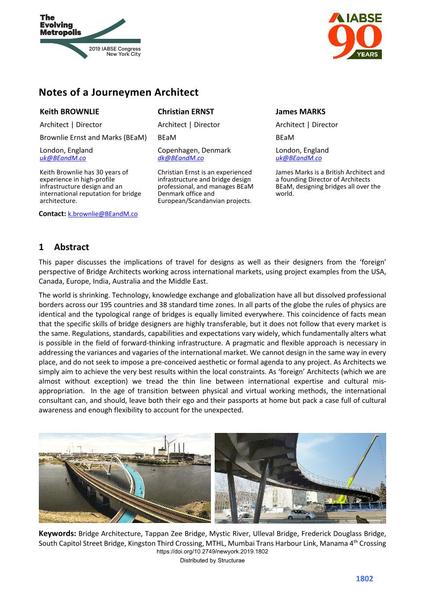Notes of a Journeymen Architect

|
|
|||||||||||
Détails bibliographiques
| Auteur(s): |
Keith Brownlie
(Brownlie Ernst and Marks (BEaM))
Christian Ernst (Brownlie Ernst and Marks (BEaM)) James Marks (Brownlie Ernst and Marks (BEaM)) |
||||
|---|---|---|---|---|---|
| Médium: | papier de conférence | ||||
| Langue(s): | anglais | ||||
| Conférence: | IABSE Congress: The Evolving Metropolis, New York, NY, USA, 4-6 September 2019 | ||||
| Publié dans: | The Evolving Metropolis | ||||
|
|||||
| Page(s): | 1802-1808 | ||||
| Nombre total de pages (du PDF): | 7 | ||||
| DOI: | 10.2749/newyork.2019.1802 | ||||
| Abstrait: |
This paper discusses the implications of travel for designs as well as their designers from the ‘foreign’ perspective of Bridge Architects working across international markets, using project examples from the USA, Canada, Europe, India, Australia and the Middle East. The world is shrinking. Technology, knowledge exchange and globalization have all but dissolved professional borders across our 195 countries and 38 standard time zones. In all parts of the globe the rules of physics are identical and the typological range of bridges is equally limited everywhere. This coincidence of facts mean that the specific skills of bridge designers are highly transferable, but it does not follow that every market is the same. Regulations, standards, capabilities and expectations vary widely, which fundamentally alters what is possible in the field of forward-thinking infrastructure. A pragmatic and flexible approach is necessary in addressing the variances and vagaries of the international market. We cannot design in the same way in every place, and do not seek to impose a pre-conceived aesthetic or formal agenda to any project. As Architects we simply aim to achieve the very best results within the local constraints. As ‘foreign’ Architects (which we are almost without exception) we tread the thin line between international expertise and cultural mis- appropriation. In the age of transition between physical and virtual working methods, the international consultant can, and should, leave both their ego and their passports at home but pack a case full of cultural awareness and enough flexibility to account for the unexpected. |
||||
